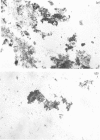Abstract
Pigment gallstones contain considerable amounts of unconjugated bilirubin (UCB) in the form of calcium bilirubinate and/or bilirubin polymers. Since more than 98% of bile pigments are excreted as conjugates of bilirubin, the source of this UCB needs to be identified. By using a rapid h.p.l.c. method, we compared the non-enzymic hydrolysis of bilirubin monoglucuronide (BMG) and bilirubin diglucuronide (BDG) to UCB in model bile and in native guinea-pig bile. Model biles containing 50 microM solutions of pure BMG and BDG were individually incubated in 25 mM-sodium taurocholate (NaTC) and 0.4 M-imidazole/5 mM-ascorbate buffer (TC-BUF) at 37 degrees C. Over an 8 h period, BMG hydrolysis produced 4-6 times more UCB than BDG hydrolysis. At pH 7.4, 25% of the BMG was converted into UCB, whereas only 4.5% of BDG was converted into UCB. Hydrolysis rates for both BMG and BDG followed the pH order 7.8 greater than 7.6 approximately equal to 7.4 greater than 7.1 Incubation with Ca2+ (6.2 mM) at pH 7.4 in TC-BUF resulted in precipitated bile pigment which, at 100 X magnification, appeared similar to precipitates seen in the bile of patients with pigment gallstones. At pH 7.4, lecithin (crude phosphatidylcholine) (4.2 mM) was a potent inhibitor of hydrolysis of BMG and BDG. The addition of a concentration of cholesterol equimolar with that of lecithin eliminated this inhibitory effect. Guinea-pig gallbladder bile incubated with glucaro-1,4-lactone (an inhibitor of beta-glucuronidase) underwent hydrolysis similar to the model bile systems. The non-enzymic hydrolysis of bile pigments, especially BMG, may be an important mechanism of bile-pigment precipitation and, ultimately, of gallstone formation.
Full text
PDF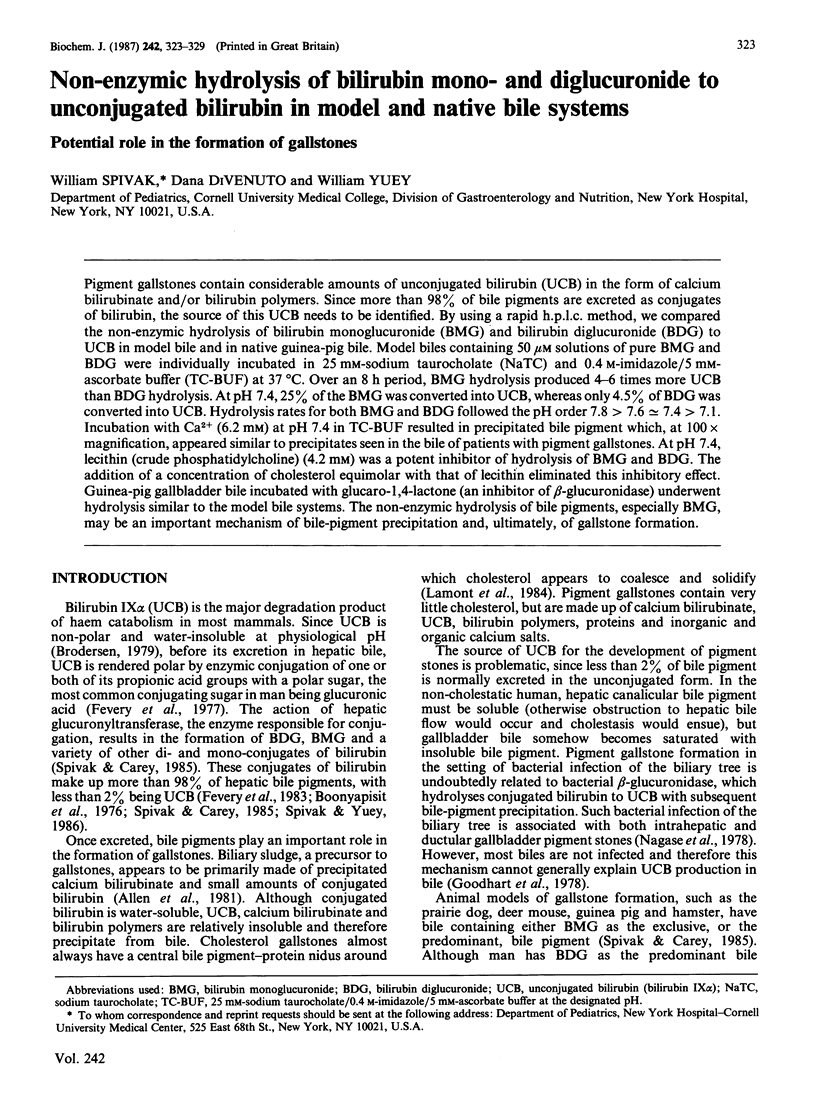
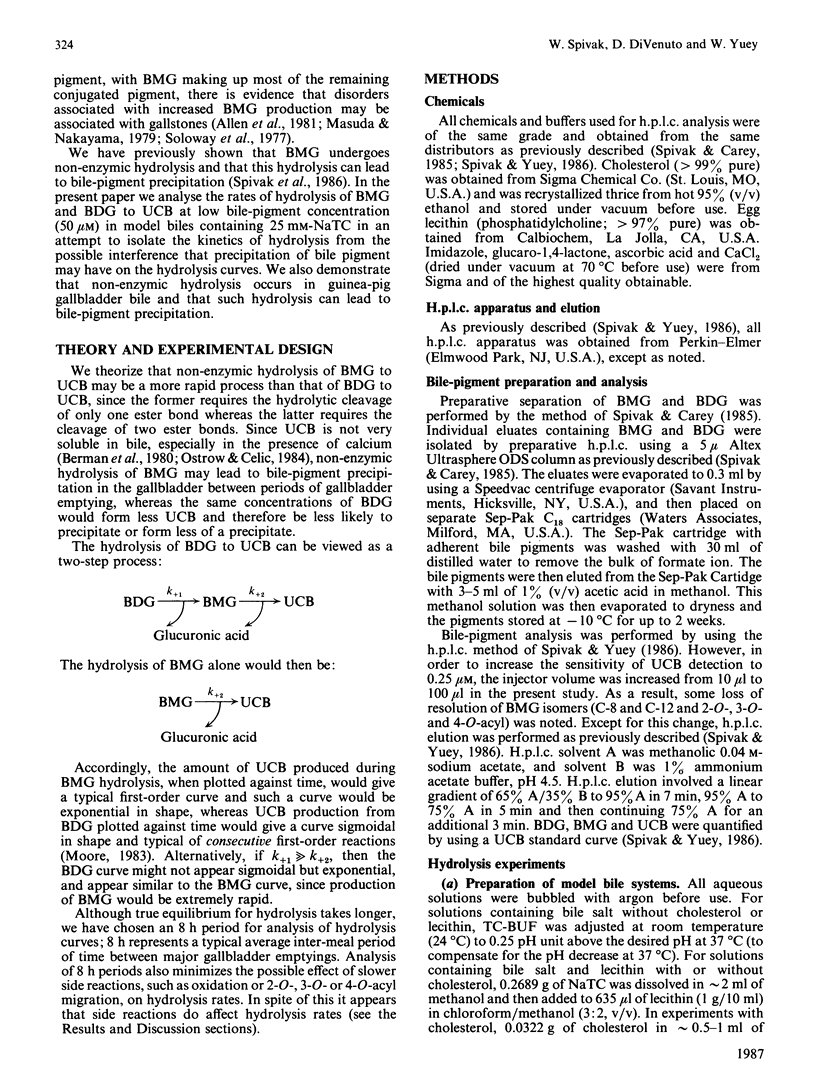
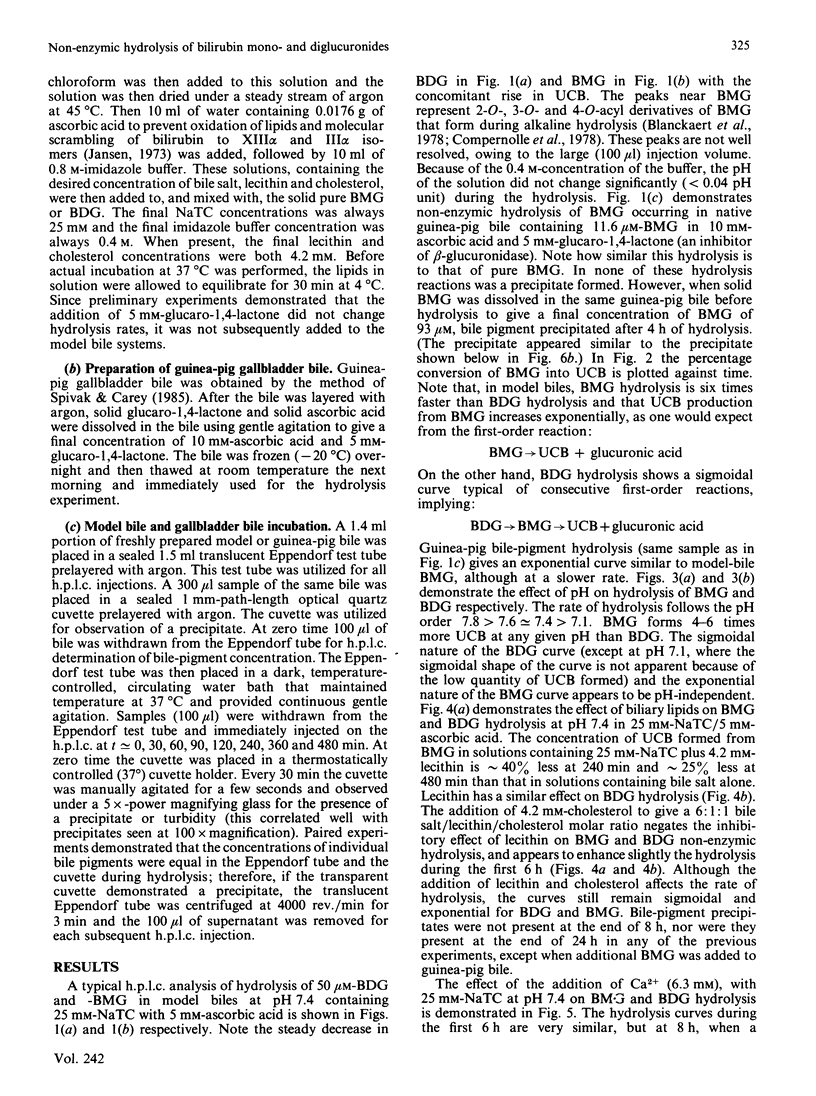
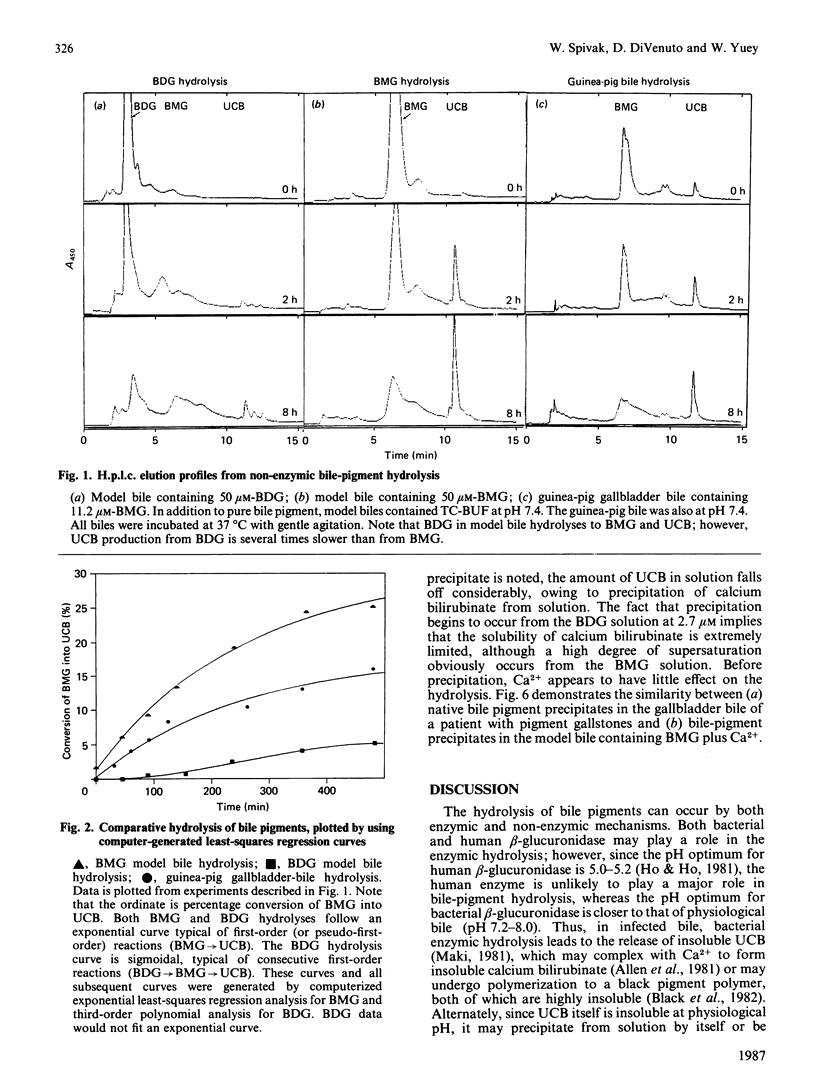
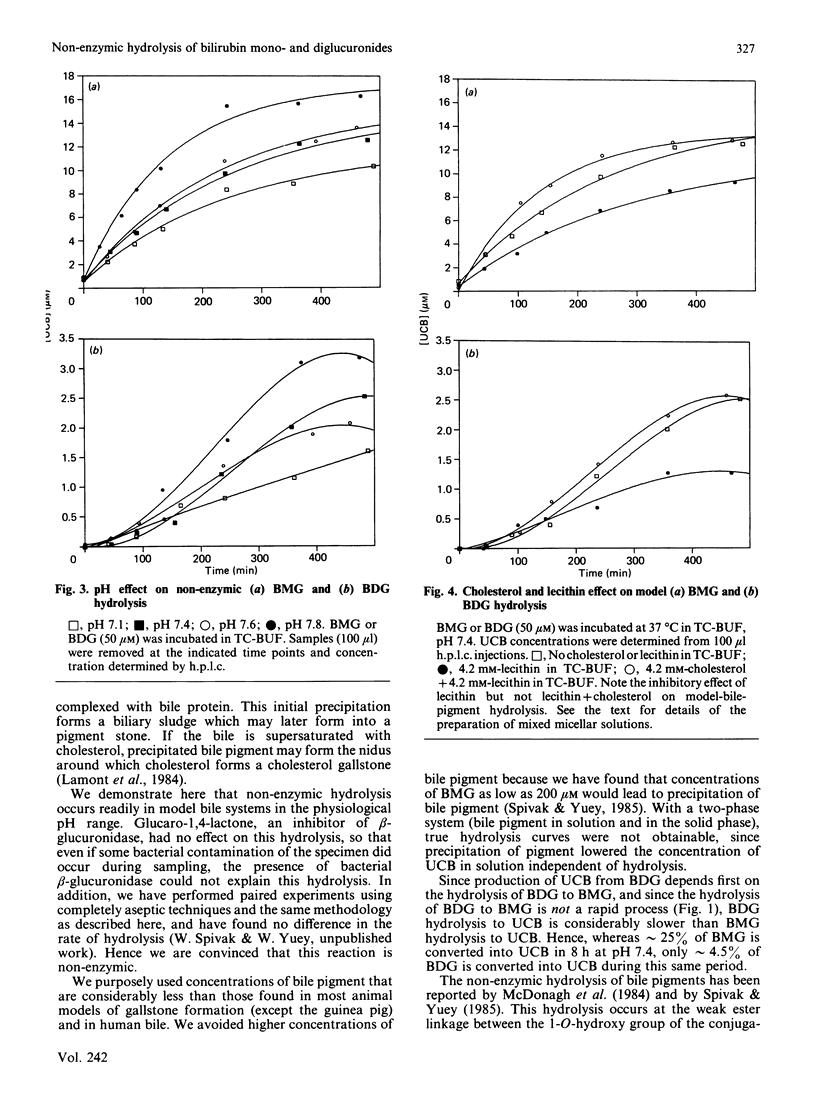
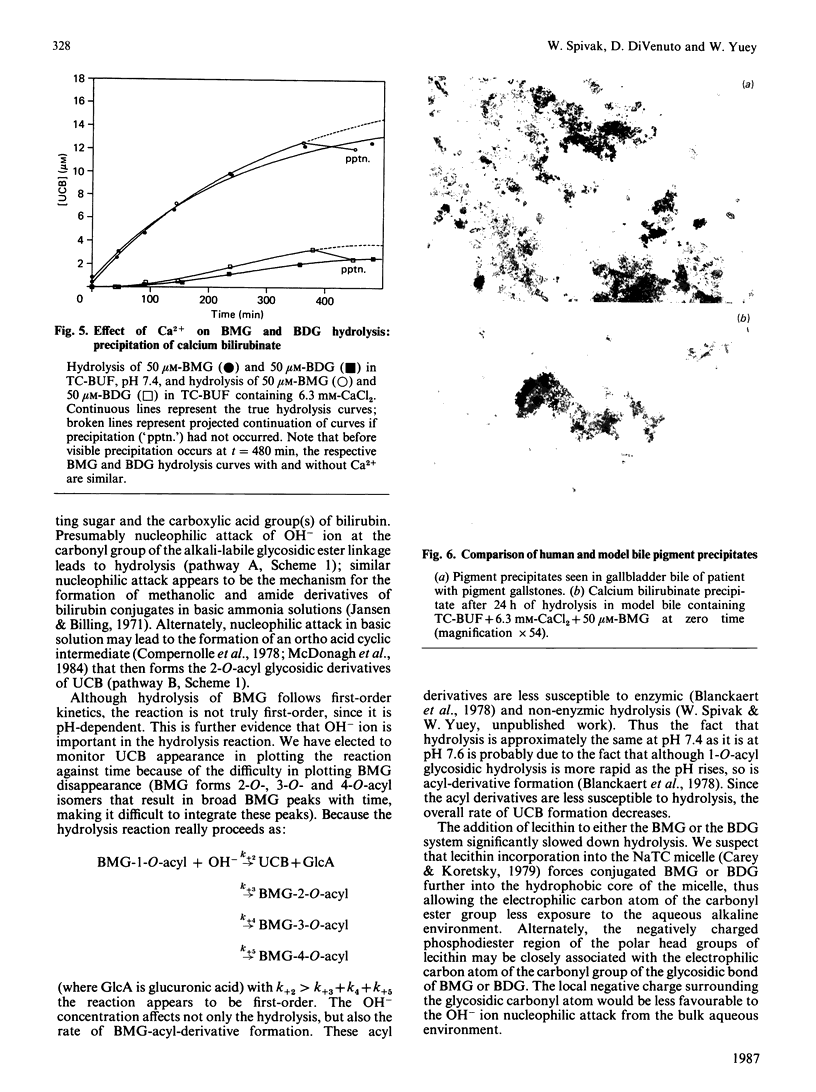
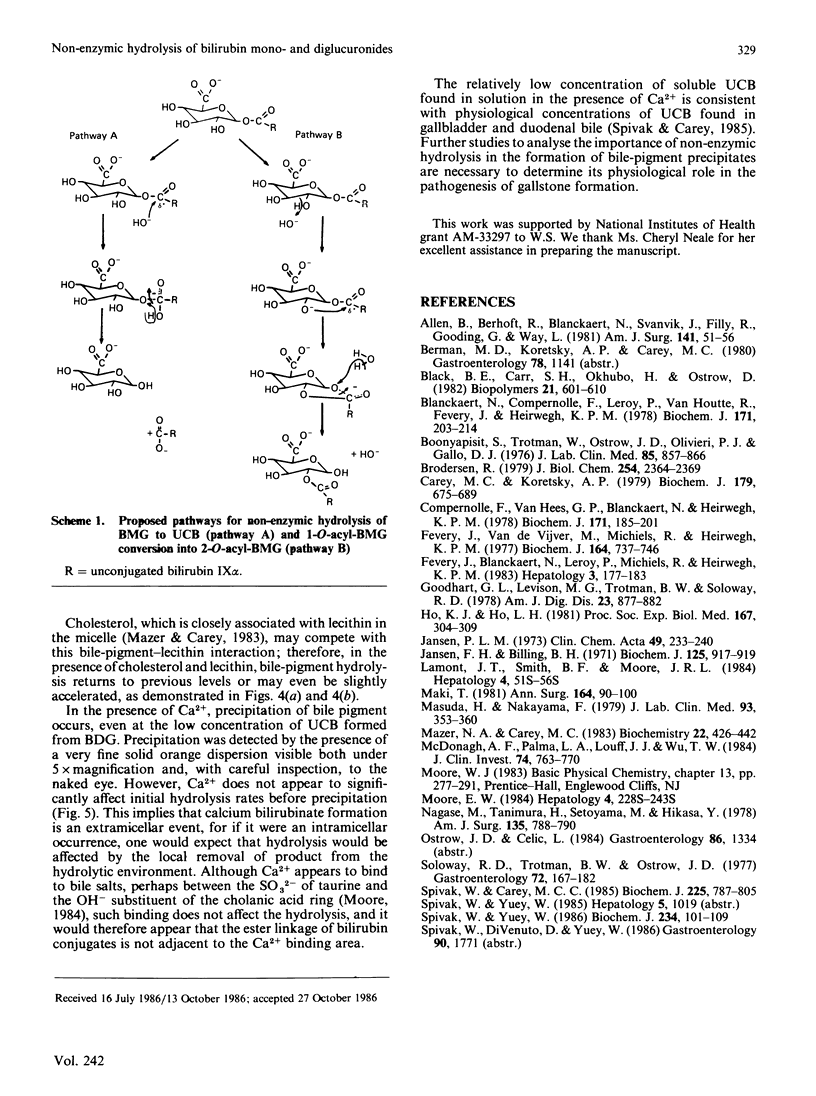
Images in this article
Selected References
These references are in PubMed. This may not be the complete list of references from this article.
- Allen B., Bernhoft R., Blanckaert N., Svanvik J., Filly R., Gooding G., Way L. Sludge is calcium bilirubinate associated with bile stasis. Am J Surg. 1981 Jan;141(1):51–56. doi: 10.1016/0002-9610(81)90011-8. [DOI] [PubMed] [Google Scholar]
- Black B. E., Carr S. H., Ohkubo H., Ostrow J. D. Equilibrium swelling of pigment gallstones: evidence for network polymer structure. Biopolymers. 1982 Mar;21(3):601–610. doi: 10.1002/bip.360210309. [DOI] [PubMed] [Google Scholar]
- Blanckaert N., Compernolle F., Leroy P., Van Houtte R., Fevery J., Heirwegh K. P. The fate of bilirubin-IXalpha glucuronide in cholestasis and during storage in vitro. Intramolecular rearrangement to positional isomers of glucuronic acid. Biochem J. 1978 Apr 1;171(1):203–214. doi: 10.1042/bj1710203. [DOI] [PMC free article] [PubMed] [Google Scholar]
- Boonyapisit S. T., Trotman B. W., Ostrow J. D., Olivieri P. J., Gallo D. Measurement of conjugated and unconjugated bilirubin in bile. II. A new thin-layer chromatographic method. J Lab Clin Med. 1976 Nov;88(5):857–863. [PubMed] [Google Scholar]
- Brodersen R. Bilirubin. Solubility and interaction with albumin and phospholipid. J Biol Chem. 1979 Apr 10;254(7):2364–2369. [PubMed] [Google Scholar]
- Carey M. C., Koretsky A. P. Self-association of unconjugated bilirubin-IX alpha in aqueous solution at pH 10.0 and physical-chemical interactions with bile salt monomers and micelles. Biochem J. 1979 Jun 1;179(3):675–689. doi: 10.1042/bj1790675. [DOI] [PMC free article] [PubMed] [Google Scholar]
- Compernolle F., Van Hees G. P., Blanckaert N., Heirwegh K. P. Glucuronic acid conjugates of bilirubin-IXalpha in normal bile compared with post-obstructive bile. Transformation of the 1-O-acylglucuronide into 2-, 3-, and 4-O-acylglucuronides. Biochem J. 1978 Apr 1;171(1):185–201. doi: 10.1042/bj1710185. [DOI] [PMC free article] [PubMed] [Google Scholar]
- Fevery J., Blanckaert N., Leroy P., Michiels R., Heirwegh K. P. Analysis of bilirubins in biological fluids by extraction and thin-layer chromatography of the intact tetrapyrroles: application to bile of patients with Gilbert's syndrome, hemolysis, or cholelithiasis. Hepatology. 1983 Mar-Apr;3(2):177–183. doi: 10.1002/hep.1840030207. [DOI] [PubMed] [Google Scholar]
- Fevery J., Van de Vijver M., Michiels R., Heirwegh K. P. Comparison in different species of biliary bilirubin-IX alpha conjugates with the activities of hepatic and renal bilirubin-IX alpha-uridine diphosphate glycosyltransferases. Biochem J. 1977 Jun 15;164(3):737–746. doi: 10.1042/bj1640737. [DOI] [PMC free article] [PubMed] [Google Scholar]
- Goodhart G. L., Levison M. E., Trotman B. W., Soloway R. D. Pigment vs cholesterol cholelithiasis: bacteriology of gallbladder stone, bile, and tissue correlated with biliary lipid analysis. Am J Dig Dis. 1978 Oct;23(10):877–882. doi: 10.1007/BF01072459. [DOI] [PubMed] [Google Scholar]
- Ho K. J., Ho L. H. Inhibitory effect of bile acids on the activity of human beta-glucuronidase at its optimal pH. Proc Soc Exp Biol Med. 1981 Jul;167(3):304–309. doi: 10.3181/00379727-167-41170. [DOI] [PubMed] [Google Scholar]
- Jansen F. H., Billing B. H. The identification of monoconjugates of bilirubin in bile as amide derivatives. Biochem J. 1971 Dec;125(3):917–919. doi: 10.1042/bj1250917. [DOI] [PMC free article] [PubMed] [Google Scholar]
- Jansen P. L. The isomerisation of bilirubin monoglucuronide. Clin Chim Acta. 1973 Dec 12;49(2):233–240. doi: 10.1016/0009-8981(73)90296-9. [DOI] [PubMed] [Google Scholar]
- Maki T. Pathogenesis of calcium bilirubinate gallstone: role of E. coli, beta-glucuronidase and coagulation by inorganic ions, polyelectrolytes and agitation. Ann Surg. 1966 Jul;164(1):90–100. doi: 10.1097/00000658-196607000-00010. [DOI] [PMC free article] [PubMed] [Google Scholar]
- Masuda H., Nakayama F. Composition of bile pigment in gallstones and bile and their etiological significance. J Lab Clin Med. 1979 Mar;93(3):353–360. [PubMed] [Google Scholar]
- Mazer N. A., Carey M. C. Quasi-elastic light-scattering studies of aqueous biliary lipid systems. Cholesterol solubilization and precipitation in model bile solutions. Biochemistry. 1983 Jan 18;22(2):426–442. doi: 10.1021/bi00271a029. [DOI] [PubMed] [Google Scholar]
- McDonagh A. F., Palma L. A., Lauff J. J., Wu T. W. Origin of mammalian biliprotein and rearrangement of bilirubin glucuronides in vivo in the rat. J Clin Invest. 1984 Sep;74(3):763–770. doi: 10.1172/JCI111492. [DOI] [PMC free article] [PubMed] [Google Scholar]
- Moore E. W. The role of calcium in the pathogenesis of gallstones: Ca++ electrode studies of model bile salt solutions and other biologic systems. With an hypothesis on structural requirements for Ca++ binding to proteins and bile acids. Hepatology. 1984 Sep-Oct;4(5 Suppl):228S–243S. [PubMed] [Google Scholar]
- Nagase M., Tanimura H., Setoyama M., Hikasa Y. Present features of gallstones in Japan. A collective review of 2,144 cases. Am J Surg. 1978 Jun;135(6):788–790. doi: 10.1016/0002-9610(78)90165-4. [DOI] [PubMed] [Google Scholar]
- Soloway R. D., Trotman B. W., Ostrow J. D. Pigment gallstones. Gastroenterology. 1977 Jan;72(1):167–182. [PubMed] [Google Scholar]
- Spivak W., Carey M. C. Reverse-phase h.p.l.c. separation, quantification and preparation of bilirubin and its conjugates from native bile. Quantitative analysis of the intact tetrapyrroles based on h.p.l.c. of their ethyl anthranilate azo derivatives. Biochem J. 1985 Feb 1;225(3):787–805. doi: 10.1042/bj2250787. [DOI] [PMC free article] [PubMed] [Google Scholar]
- Spivak W., Yuey W. Application of a rapid and efficient h.p.l.c. method to measure bilirubin and its conjugates from native bile and in model bile systems. Potential use as a tool for kinetic reactions and as an aid in diagnosis of hepatobiliary disease. Biochem J. 1986 Feb 15;234(1):101–109. doi: 10.1042/bj2340101. [DOI] [PMC free article] [PubMed] [Google Scholar]



